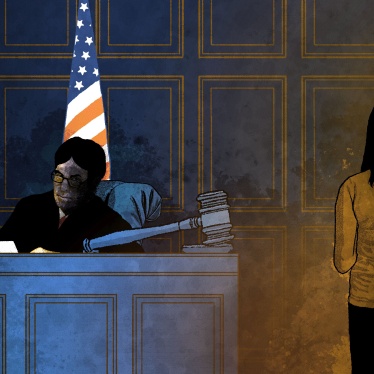Dear Representative:
On behalf of Human Rights for Kids, the Campaign for the Fair Sentencing of Youth, the Campaign for Youth Justice, and the additional undersigned organizations, we write to express our full support of H.R. 1949, H.R. 1950, and H.R. 1951 by Congressman Bruce Westerman (R-AR), and encourage you to sign-on to this legislation as a co-sponsor.
H.R. 1949 addresses the use of mandatory minimum sentences on all children in the federal criminal justice system. Under this measure, judges will consider how children are different from adult offenders prior to sentencing and will be allowed to depart up to 35 percent away from the otherwise applicable mandatory minimum sentence.
H.R. 1950 - also known as Sara's Law - will allow judges to depart from any mandatory minimum sentence or suspend any portion of a sentence when a child has committed a crime against someone who has previously sex trafficked or sexually abused them.
And H.R. 1951 will allow children sentenced to more than 20 years in prison for crimes committed before their 18th birthday to petition the original sentencing court for review of their sentence after they have served 20 years of their sentence. This legislation will end life and de facto life without parole sentences for children and bring the federal government into compliance with the U.S. Supreme Court’s decisions in Graham v. Florida, Miller v. Alabama, and Montgomery v. Louisiana.
Too little attention has been paid to children in the criminal justice system. From arrest to sentencing and incarceration, our treatment of children in the justice system is long overdue for re-examination and reform.
In the late 1980s and early 1990s, states began passing laws to make it easier to transfer children into the adult criminal justice system, which exposed children to harsh mandatory minimum sentences and mandatory sentencing enhancements, as well as extreme sentences like life without parole. By the year 2000, a child as young as 10 years old could be tried as an adult for certain offenses. An estimated 76,000 children are prosecuted in the adult criminal justice system every year in the United States.[1] These children can face severe punishment that is not age-appropriate and is disproportionate given their young age and lessened culpability relative to that of adults.
Studies have shown that children’s brains are not fully developed. The pre-frontal cortex, which is responsible for temporal organization of behavior, speech, and reasoning continues to develop into early adulthood. Children’s underdeveloped brains and proclivity for impetuous decision-making is why we do not allow children to vote, enter into contracts, work in certain industries, get married, join the military, or use alcohol or tobacco products. These policies recognize that children are impulsive, immature, and lack solid decision-making abilities until they have reach adulthood. The one area where we do not treat children differently than adults is in our criminal justice system, where we have been too quick to discard child-status and throw children to the mercy of a system that was never designed with them in mind.
The vast majority of children involved in the criminal justice system are contending with early childhood trauma and unmitigated Adverse Childhood Experiences (ACEs), including psychological, physical, and/or sexual abuse; witnessing domestic violence; living with family members who are substance abusers, suffer from mental illness or suicidal ideation, or are incarcerated. Studies have shown that approximately 90 percent of children in the juvenile justice system have experienced at least two ACEs, and 27 percent of boys and 45 percent of girls have experienced at least five ACEs.[2] For children sentenced to life in prison, nearly 80 percent of them reported witnessing violence in their homes, 50 percent were physically abused, and 20 percent were sexually abused during their life.[3] However, the justice system rarely recognizes or understands the connection between children who have committed a criminal act and their previous exposure to trauma.
The lack of regard for child status and the failure to account for the impact of early childhood trauma in children transferred into the adult criminal justice system should be seen through a human rights lens – especially for youth of color and youth from low socio-economic backgrounds who make up the vast majority of children harmed by the justice system. Black children comprise 58 percent of all children confined in adult prisons.[4] Roughly 83 percent of children prosecuted in the adult criminal justice system are racial minorities,[5] where black children represent 87 percent of drug cases, 48 percent of property cases, and 63 percent of public order offense cases.[6]
H.R. 1949, H.R. 1950, and H.R. 1951 are about mercy and redemption for America’s children and represent common-sense reform that properly balances protecting public safety with the need to treat children differently from adults in the federal criminal justice system. This package of reform legislation provides appropriate discretion to judges when sentencing children and refocuses sentencing considerations to better account for a child’s background and exposure to early childhood trauma. It also guarantees children the opportunity for sentencing review after a reasonable point into their incarceration.
These bills better align with our values as being a nation of second chances and our belief that there is no such thing as a ‘throw-away’ child. The great Nelson Mandela once said, “there is no keener revelation of a society’s soul than the way in which it treats its children.” What does it say about our soul then when we allow children to be sentenced to die in prison? Or when we do not account for child-status or the trauma children have experienced prior to sentencing them as if they were an adult? Or when we allow child sex crime victims to be sentenced to decades in prison for acts of violence they commit against their abusers
Current policies do not recognize the capacity for change inherent in every person, especially children, and deprive children of liberty for longer than necessary for public safety. It is for these reasons that we urge you to support all three measures by Congressman Westerman and sign on as a co-sponsor.
Sincerely,
Human Rights for Kids
Campaign for Youth Justice
Campaign for the Fair Sentencing of Youth
Right on Crime
R Street
NAACP
American Psychological Association
Center for Children's Law and Policy
FAMM
The Sentencing Project
Southern Poverty Law Center
Human Rights Watch
Futures Without Violence
Color of Change
Justice Policy Institute
Coalition for Juvenile Justice
School Social Work Association of America
AFL-CIO
MomsRising
United for Human Rights
National Juvenile Justice Network
Girls Inc.
African American Ministers In Action
National Crittenton
Open City Advocates
StoptheDrugWar.org
Mennonite Central Committee (D.C. Office)
National Network for Youth
National Council on Independent Living
[1] Charles Puzzanchera, Melissa Sickmund, and Anthony Sladky, Nat’l Center for Juvenile Justice, Youth Younger than 18 Prosecuted in Criminal Court: National Estimate, 2015 Cases (2018), http://www.cfyj.org/images/Transfer-estimate.pdf.
[2] Human Rights for Kids (2018). https://humanrightsforkids.org/wp-content/uploads/2018/12/HRFK-ACES-Infographic-final.pdf
[3] Ashley Nellis, The Lives of Juvenile Lifers, The Sentencing Project (2012). sentencingproject.org/doc/publications/jj_The_Lives_of_Juvenile_Lifers.pdf
[4] U.S. Department of Justice, OJJDP, Disproportionate Minority Contact (DMC).
[5] Campaign for Youth Justice, “To Punish A Few: Too Many Youth Caught in the Net of Adult Prosecution”, 2007.
[6] Id.






